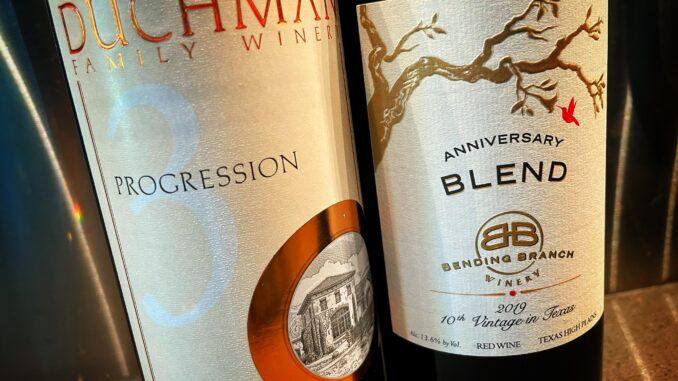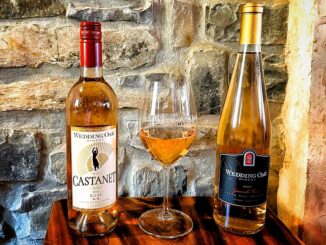
Today, we are going to taste at two Texas Fine Wine partner wineries: Duchman Family Winery and Bending Branch Winery. Our focus is to answer a particular question. What makes red blends so good?
Simply put, they can offer a broadened and enhanced experience than possible from most single variety wines. On these tasting stops, we are tasting two blended wines, one Duchman Progression 3 and Bending Branch Winery Anniversary Blend. Both wineries know how to blend with synergy to get a 1 + 1 = 3 or 3 + 2 = 10 result, and they also add a twist of unconventionality to boot.
Let’s start just outside of Austin heading to the southwest on Mopac then on Route 1826 essentially rimming the rough eroded edge of the Balcones Fault, the defining geological feature of the Texas Hill Country. Finally, near the hamlet of Driftwood TX, we make a left turn on to Route 150, but keep alert to make another left into Duchman Family Winery.

In review, blended wines can be made to accentuate color, body, fruit intensity and/or tannin level or to make a softer, silkier and more approachable or multifaceted wine. Blends are often based on historical influences in France or Italy. But, because wine laws are less formal in the States than they are in Europe, we can find blended wines using grapes that you would never in your life find blended together in Europe. My case in point is the first wine.

Duchman Family Winery, Progression 3, Texas Red Wine (100% Texas Grapes)
Progression 3 follows two of Duchman’s most popular wines ever, Progression 1 & 2. It is a multi-varietal, multi-vintage wine, meaning that it is made from more than one variety of grape and also includes wine made from grapes of different vintage years. This is the way that most French Champagne is made, and that’s a good pedigree for this technique.
Winemaker Dave Reilly, has aged this wine over 30 months in American, Hungarian and French Oak so it is both ready to drink now or bottle age for a number of years to come. The nose is full with dark fruits, baking spice and cedar. The palate consists of rich blackberry and black cherry with a comfortable tannic structure and a very long finish. It gets this character from the integration of Texas Aglianico and Montipulciano grapes that bring together luscious fruit from the Montipulciano with the characteristic firm tannins from Aglianico. These are two grapes with their heritages in different regions of Italy, and unlikely ever blended together until they were grown here in Texas and met winemaker Dave Reilly.
Let’s hit the road again, heading in a westerly direction through Blanco, then snake a bit south on Route 281 and west on Route 473 to Comfort, TX. Just past town, we weave our way next to the Guadalupe River to Bending Branch Winery. There, we are ready to experience another red blend much different from the first. This wine is a brainchild of winery owner Dr. Bob Young to commemorate the winery’s tenth anniversary. It’s what is know as a ”four-blend”, consisting of four different varieties of grapes that starts out like a usual Bordeaux-style red with components of Cabernet Sauvignon, Merlot and some Petit Verdot. But, that’s where conventionality ends.

The Cabernet, Merlot and Petit Verdot were combined with a grape is rarely grown outside California. It is Petite Sirah, known for producing deep inky color and full-bodied wines. Dr. Bob is known to push what might be considered conventional limits of fermentation in his quest for extracting color and aromatics from Texas-grown grapes. As we have explored previously (click here), his approach to fermentation is hands on and definitely reactive to what the vintage provides.
Bending Branch Winery, 2019 Anniversary Blend, Texas High Plains
In this wine, the Cabernet Sauvignon and Petite Sirah components were made with a combination of cryomaceration (freezing the grapes before fermentation) and flash détente (a more innovative technique involving rapid heating/cooling with vacuum applied) all with the aim of maceration of the grape skins to release more flavor and tannin compounds. The Malbec was made with flash détente, while the Petit Verdot (another dark inky grape) was made with regular fermentation methods.
My take on this wine is that it is a neo-Bordeaux-style blend made by Bending Branch Winery (The Tannat House of Texas) that is known for making intense wines. In this case, after 19 months in 50% neutral and 50% French oak, the wine is rich to near-opulent in character. It has notes of blackberry, blueberry, dried strawberry, spicy cardamom and even a lingering floral note of violets on the nose.

I hope you enjoyed our tasting stops in this blog and find the opportunity to stop at these wineries yourself or go online to obtain these special red blended wines. Check out the website links for these wineries and join the revolution in Texas wines.
Click the link for more information on these wineries, wines, awards, and online/live events planned by Texas Fine Wines.

Be the first to comment